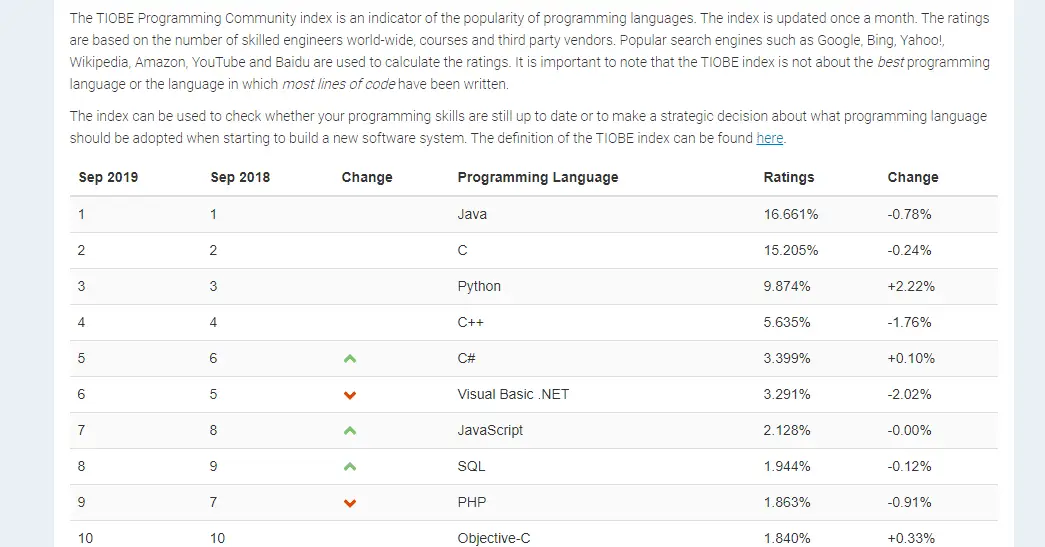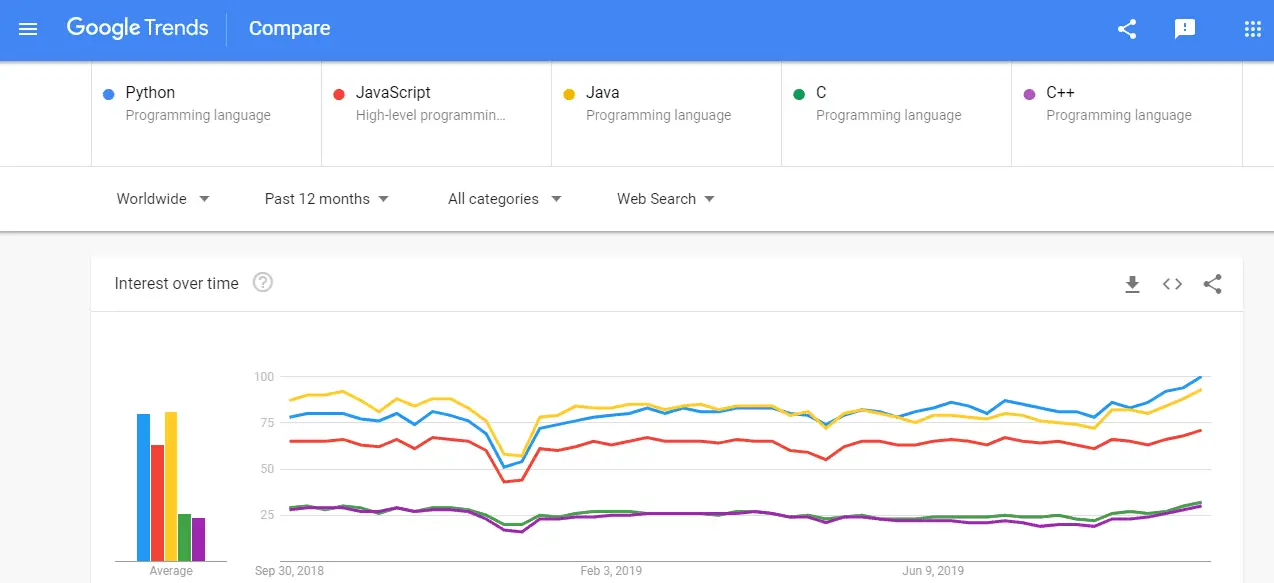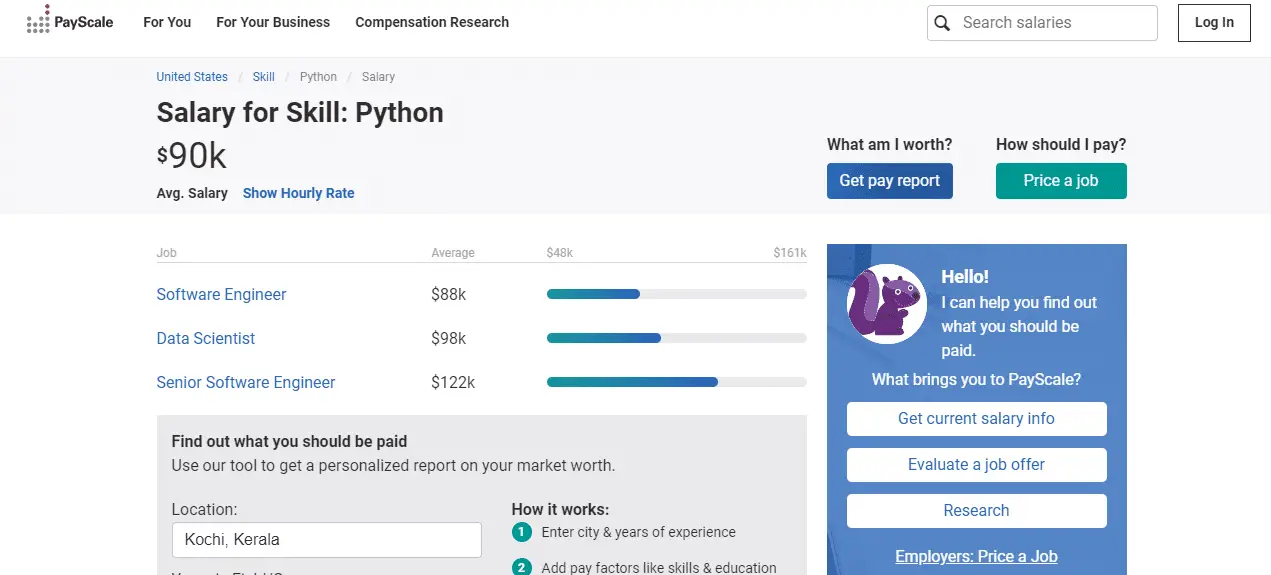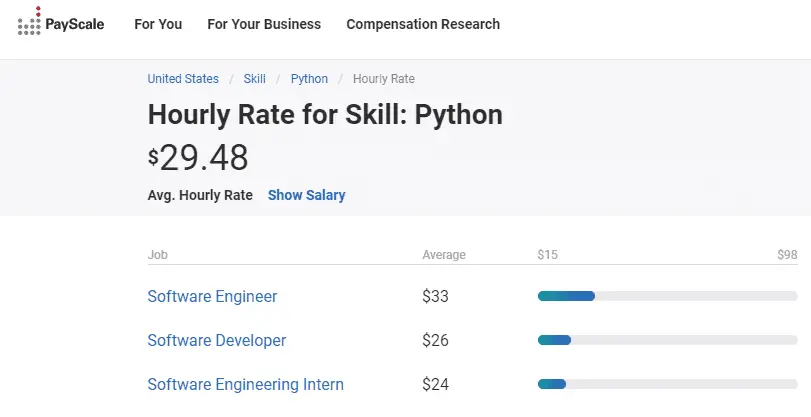There are countless programming languages that you can choose to start your career as a software developer. Sometimes it’s hard to know what programming language will be best for you and which one you’ll get the most out of. I like to recommend Python because there are so many things that you can do with it!
Python has a lot of advantages when we compare it with other programming languages. Let’s find out what are the things that make Python stand out among programming languages.
Here are some of the exciting advantages of Python:
1. Python is the Easiest Programming Language in the World
When it comes to breaking into a career as a developer or adding a new coding language to your skillset, Python is easier to pick up than others. A survey conducted by WPEngine reveals that Python is the simplest language to learn.
WP Engine surveyed 909 developers across the United States. According to the survey, Python is at the second position just below HTML. But, HTML is not a programming language. It is a markup language used to build the structure of a website. So, Python grabs first place among programming languages [Source].
Python is famous for its high readability, and simple and easy to learn syntax. The syntax of Python is very simple and doesn’t contain any curly braces or semicolons.
The language is more easily readable and is similar to the English language. That is why most of the universities are teaching Python as the introductory programming language to their students.
The simple syntax of Python emphasizes readability and enforces a good programming style, such as indenting and the importance of naming conventions. You can express concepts in far fewer lines of code and focus more on logic and algorithm.
So, if you are a beginner who doesn’t know anything about programming, Python is the easiest language to start. It can be used as a stepping stone into other frameworks and technologies.
2. Python is a Hugely Popular Language
Python is the most in-demand programming language in the world right now. According to the TIOBE Programming Community Index (It is an indicator of the popularity of programming languages), Python has reached its highest rating ever this month.
On its current trajectory, TIOBE noted, Python could leapfrog Java and C in the next three or four years to become the most popular language of the index. According to them, Java is still the popular programming language in the world (by the time I’m writing this article). Python offers ease of use that Java and C do not and is attracting a lot of newcomers.
Here is a list of the top 10 programming languages by the time I’m writing this article (September 2019). You can click this link to check the current ratings. Hopefully, Python would be more popular by the time you’re reading this article.

From the above screenshot, you can see that Python is improving its popularity while Java and C are becoming less popular.
But, when it comes to Google, Python has already beaten Java in terms of the popularity of programming languages. I just opened Google Trends (a tool where you can check what is trending) and compared the popularity of Python, Javascript, Java, C, and C++. Guess who is winning the battle? It’s Python.
Here is a screenshot of my comparison. You can see that Python is overtaking Java as the popular programming language in the world.


You can also do this experiment by going to Google Trends.
It is visible that Python is beating other programming languages. Hence, it is the best time to learn Python. The future of the language looks bright.
3. Write Python Once, Run it Anywhere
Python is a ‘Write Once Run Anywhere(WORA)‘ language. What do I mean by that? It means that the Python language is platform-independent. Platform independence refers to a programming language allowing programmers to implement things on one machine and use them on another machine, without any (or with only minimal) changes.
Python code can be used to create standalone executable programs for most common operating systems. It can be used on Linux, Windows, Macintosh, Solaris, and many more.
When you code your project in a language like C++, you may need to make some changes to it if you want to run it on another platform. C++ is not platform-independent.
But it isn’t the same with Python. Here, you need to code only once, and you can run it anywhere. However, you need to be careful enough not to include any system-dependent features.
Any Python code that you write gets converted into Python byte code. It is a set of lower-level instructions that are meant to be understood by a virtual machine (VM).
The virtual machine is then responsible for converting (interpreting) the byte code to an even lower-level set of instructions (in the form of 0s and 1s) which are meant to be understood by the computer.
The only problem with portability in Python is the still-prevailing use of Python 2 and Python 3 together. Python 3 is fundamentally different than Python 2 and even has different semantics under particular cases.
Therefore, Python 2 code is generally not runnable on a Python 3 machine and vice-versa. It makes portability a little problematic. But most of the legacy code has already been ported to Python 3. So, the problem is likely to go away soon.
4. Python is a Free and Open Source Language
Python is developed under an OSI-approved open source license, making it freely usable and distributable, even for commercial use. But not only can you download python for free, but you can also download its source code, make changes to it, and even distribute it.
All Python releases are Open Source. You can read more about the history and license of Python by clicking here.
Python programming language has a massive support base. Millions of like-minded developers work with the language daily and continue to improve its core functionality.
According to Stack Overflow (the largest programming community), Python is one of the most wanted programming languages. If you have any doubts regarding Python programming, go to stackoverflow.com and ask your questions.
For any task you may have, the chance is pretty high that someone else out there has dealt with the same problem. You’ll get help very fast. There are a lot of Python programmers who would love to help you.
5. Machine Learning, the Next Big Thing!
When it comes to machine learning, which is the most booming technology right now, Python is the most used programming language. To implement artificial intelligence, you should use a programming language that is stable, flexible, and has tools available.
Python offers all of this, which is why we see lots of Python AI projects today. Python, with its rich technology stack, has an extensive set of libraries for artificial intelligence and machine learning.
Python comes up with a lot of in-built libraries like Tensorflow, Keras, Scikit-learn, etc., which helps programmers to implement machine learning and deep learning easily.
It also provides Numpy for numerical calculations, Pandas for data analysis, Seaborn for data visualization, Scipy for advanced computing, and a lot more.
Scikit-learn features various classification, regression, and clustering algorithms, including support vector machines, random forests, gradient boosting, k-means, etc., and is designed to work with the Python numerical and scientific libraries NumPy and SciPy.
Programmers turn to several Python frameworks and libraries to reduce development time. It can do a set of complex machine learning tasks and enable you to build prototypes quickly.
6. Extensive Set of Libraries and Frameworks
Python has a wide variety of libraries and frameworks available for various needs. A software library is a suite of pre-written code that developers use to solve common programming tasks. These libraries help programmers to do more stuff by writing less code.
Python has libraries for almost everything, including machine learning, web development, graphical user interface design, mobile development, and many more.
Tensorflow, Keras, Scikit-learn, Numpy, Scipy, Pandas, OpenCV, PIL, etc., are some of the popular libraries of Python which are very helpful in the machine learning field.
Python has web frameworks like Django and Flask, which can be used to build amazing web applications. A lot of developers use these frameworks to make cool web apps.
Tkinter is a popular library that is used to build a graphical user interface for desktop applications in Python. Even though Python is not so popular in mobile development, libraries like Kivi make it possible to create mobile applications using Python.
These libraries can help you to develop your product faster. Python programmers won’t have to reinvent the wheel and can use an existing library to implement necessary features for their software.
7. Many Top Software Companies Use Python
Python is used by various technology giants to create their software. Do you know which are the top tech companies that use Python? Here is a list of a few of them.
- Dropbox
- Hipmunk
- Spotify
- Netflix
- Quora
- Eventbrite
The list goes on and on. Even NASA uses Python for its various projects. As of now, Python adoption has reached a new peak and continues to climb.
8. Python is one of the Highly Paid Programming Languages
Python is one of the most in-demand technology and is used by many of the top tech companies. So, it is evident that Python developers get paid a lot.
According to Payscale.com, the average annual salary of a Python developer is 90,000 US dollars (In September 2019).

You can click here and check the current salary of a Python developer. You can also enter your location so that it will specifically tell the salary of a Python developer in that particular area.
From the screenshot given above, you can see that a senior software engineer who codes in Python makes about 122000 USD. This website will also tell you the average hourly rate as well.

An average Python developer makes around 30 dollars per hour. You can make a lot more than that if you have the technical as well as soft skills to do freelancing.
The importance of soft skills is often undervalued, and there is far less training provided for them than technical skills such as coding. That is why I highly recommend the book Soft Skills written by my favorite YouTuber, John Sonmez.
This book changed my life. I highly recommend you to read this book, especially if you are a programmer. Click here to get this book from Amazon.
9. Django is Powered by Python
Django is a powerful web development framework, which is great for creating database-driven web applications. It is used by many top companies and freelancers to build their web apps. Some of the best Django apps include Pinterest, The Washington Post, Dropbox, and Spotify.
If you want to take a look at the list of websites that are created using Django, then check out this link. Each year, more and more apps are being added to this list.
You don’t need to rewrite any existing code. It is well-suited for high-load systems and can decrease development time. Django is a Model–View–Template (MVT) framework. The three layers (Model, View, and Template) are responsible for different things and can be used independently.
You will even get an admin interface without doing any coding. Django has a lot of such features which make things easy. For small-scale projects though, it is not the best option. You can use Flask, which is another Python framework if you want to do things easily and quickly.
But, Django has a lot more large-scale purposes. There is a small learning curve. But, once you learn the framework, it will make your web application development very easy.
If you want to get started learning Django, check out this tutorial. It will teach you how to get started with Django and create a basic hello world app.
10. Python is an Interpreted Language
Python is an interpreted programming language, which means that you don’t need to bother learning how to compile code. Since it does not have the compilation step, productivity is increased. Moreover, the time for editing, testing, and debugging the code, is considerably reduced.
You can simply download an integrated development environment (IDE), write your code, and run it. When you download the python software, it also includes the IDLE (Integrated Development and Learning Environment). You don’t need any extra code editors to write code. You can use IDLE for everything.
Conclusion
Python programming is easy and fun. Python provides remarkable power with very clear syntax. You can do a lot of stuff with it, and its demand has exploded over the past few years.
I listed out some of the cool advantages of Python. There are a lot more pros that I didn’t mention. If you have any ‘Python Power’ to add to this list, let the world know by commenting down below.
Python has a few disadvantages as well, just like every other programming language. If you want to take a look at those, check out this article.
If you have any doubts or queries, let me know in the comments. I will be happy to help you.
I would appreciate it if you would be willing to share this article. It will encourage me to create more informational articles like this.
Happy coding!

